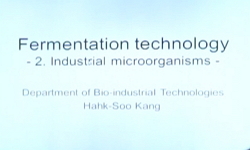Biohydrogen production from organic wastewater by anaerobically activated sludge fermentation has already been extensively investigated, and it is known that hydrogen can be produced by glucose fermentation through three metabolic pathways, including ...
http://chineseinput.net/에서 pinyin(병음)방식으로 중국어를 변환할 수 있습니다.
변환된 중국어를 복사하여 사용하시면 됩니다.
- 中文 을 입력하시려면 zhongwen을 입력하시고 space를누르시면됩니다.
- 北京 을 입력하시려면 beijing을 입력하시고 space를 누르시면 됩니다.



Metabolic Pathways of Hydrogen Production in Fermentative Acidogenic Microflora = Metabolic Pathways of Hydrogen Production in Fermentative Acidogenic Microflora
한글로보기https://www.riss.kr/link?id=A60103805
-
저자
( Li Guo Zhang ) ; ( Jian Zheng Li ) (Harbin Institute of Technology) ; ( Qiao Ying Ban ) (Harbin Institute of Technology) ; ( Jun Guo He ) (Harbin Institute of Technology) ; ( Ajay Kumar Jha ) (Harbin Institute of Technology)
- 발행기관
- 학술지명
- 권호사항
-
발행연도
2012
-
작성언어
Korean
- 주제어
-
KDC
475
-
등재정보
SCIE,SCOPUS,KCI등재
-
자료형태
학술저널
-
수록면
668-673(6쪽)
- DOI식별코드
- 제공처
- 소장기관
-
0
상세조회 -
0
다운로드
부가정보
다국어 초록 (Multilingual Abstract)
Biohydrogen production from organic wastewater by anaerobically activated sludge fermentation has already been extensively investigated, and it is known that hydrogen can be produced by glucose fermentation through three metabolic pathways, including the oxidative decarboxylation of pyruvic acid to acetyl-CoA, oxidation of NADH to NAD+, and acetogenesis by hydrogen-producing acetogens. However, the exact or dominant pathways of hydrogen production in the anaerobically activated sludge fermentation process have not yet been identified. Thus, a continuous stirred-tank reactor (CSTR) was introduced and a specifically acclimated acidogenic fermentative microflora obtained under certain operation conditions. The hydrogen production activity and potential hydrogen-producing pathways in the acidogenic fermentative microflora were then investigated using batch cultures in Erlenmeyer flasks with a working volume of 500 ml. Based on an initial glucose concentration of 10 g/l, pH 6.0, and a biomass of 1.01 g/l of a mixed liquid volatile suspended solid (MLVSS), 247.7 ml of hydrogen was obtained after a 68 h cultivation period at 35±1oC. Further tests indicated that 69% of the hydrogen was produced from the oxidative decarboxylation of pyruvic acid, whereas the remaining 31% was from the oxidation of NADH to NAD+. There were no hydrogen-producing acetogens or they were unable to work effectively in the anaerobically activated sludge with a hydraulic retention time (HRT) of less than 8 h.
동일학술지(권/호) 다른 논문
-
- 한국미생물 · 생명공학회
- ( Jian Shun Chen )
- 2012
- SCIE,SCOPUS,KCI등재
-
- 한국미생물 · 생명공학회
- ( M. M. Hasan )
- 2012
- SCIE,SCOPUS,KCI등재
-
- 한국미생물 · 생명공학회
- ( Haghani Karimeh )
- 2012
- SCIE,SCOPUS,KCI등재
-
Identification of Chinese Cabbage Sentrin as a Suppressor of Bax-Induced Cell Death in Yeast
- 한국미생물 · 생명공학회
- ( Sawitri Widhi Dyah )
- 2012
- SCIE,SCOPUS,KCI등재




 ScienceON
ScienceON KISS
KISS




